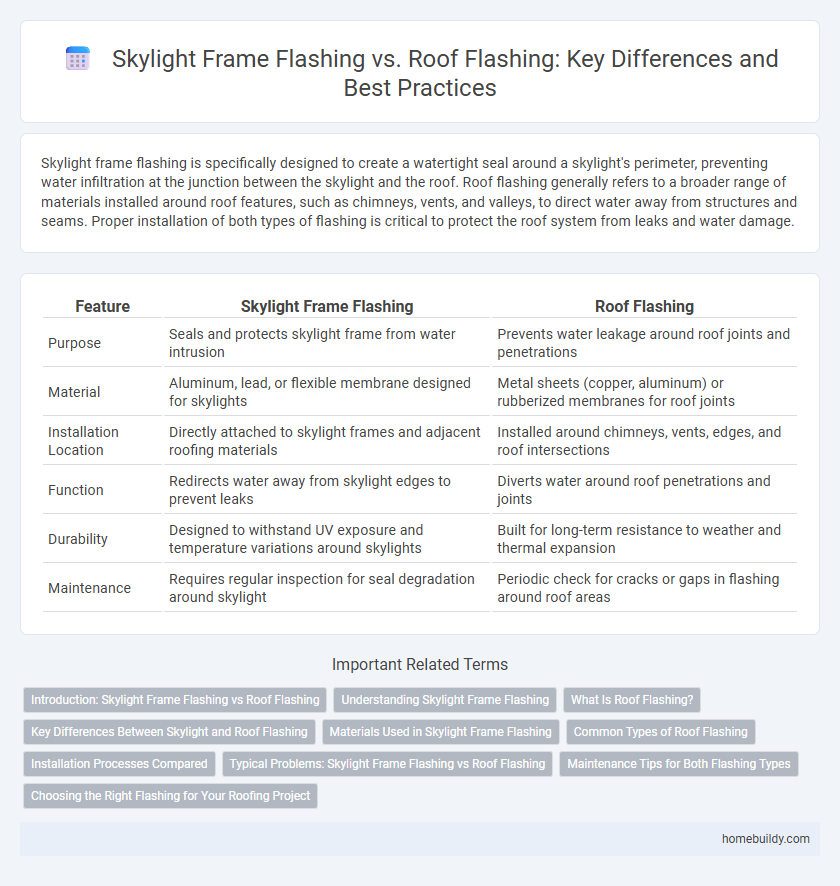Skylight frame flashing is specifically designed to create a watertight seal around a skylight's perimeter, preventing water infiltration at the junction between the skylight and the roof. Roof flashing generally refers to a broader range of materials installed around roof features, such as chimneys, vents, and valleys, to direct water away from structures and seams. Proper installation of both types of flashing is critical to protect the roof system from leaks and water damage.
Table of Comparison
| Feature | Skylight Frame Flashing | Roof Flashing |
|---|---|---|
| Purpose | Seals and protects skylight frame from water intrusion | Prevents water leakage around roof joints and penetrations |
| Material | Aluminum, lead, or flexible membrane designed for skylights | Metal sheets (copper, aluminum) or rubberized membranes for roof joints |
| Installation Location | Directly attached to skylight frames and adjacent roofing materials | Installed around chimneys, vents, edges, and roof intersections |
| Function | Redirects water away from skylight edges to prevent leaks | Diverts water around roof penetrations and joints |
| Durability | Designed to withstand UV exposure and temperature variations around skylights | Built for long-term resistance to weather and thermal expansion |
| Maintenance | Requires regular inspection for seal degradation around skylight | Periodic check for cracks or gaps in flashing around roof areas |
Introduction: Skylight Frame Flashing vs Roof Flashing
Skylight frame flashing creates a watertight seal directly around the skylight structure, preventing water infiltration at the frame-to-glass junction. Roof flashing, by contrast, integrates with roofing materials to redirect water away from the skylight and roof intersections. Proper installation of both skylight frame flashing and roof flashing is critical for ensuring long-term weather resistance and preventing leaks.
Understanding Skylight Frame Flashing
Skylight frame flashing is a specialized waterproofing component designed to seal the joint between the skylight and the roof structure, preventing water infiltration and ensuring long-term durability. Unlike general roof flashing, which covers various roof penetrations and edges, skylight frame flashing conforms precisely to the skylight's perimeter, integrating with roofing materials to manage water flow effectively. Proper installation of skylight frame flashing is critical for maintaining the integrity of both the skylight and roof, reducing the risk of leaks and structural damage.
What Is Roof Flashing?
Roof flashing is a critical waterproofing component made of metal or plastic designed to direct water away from roof joints and openings, preventing leaks and structural damage. It is installed around roof penetrations such as chimneys, vents, and skylight frames to create a sealed barrier against rain and snow infiltration. Unlike skylight frame flashing, which is specifically tailored to fit and secure skylight edges, roof flashing covers broader areas to protect the overall roofing system from water intrusion.
Key Differences Between Skylight and Roof Flashing
Skylight frame flashing is specifically designed to create a watertight seal between the skylight and the roofing material, preventing leaks around the window frame. Roof flashing, in contrast, generally protects roof joints and transitions such as chimneys, vents, and valleys from water infiltration. Key differences include the tailored fit of skylight flashing to accommodate skylight slopes and frames, whereas roof flashing is more varied in shape and size depending on the roof element it protects.
Materials Used in Skylight Frame Flashing
Skylight frame flashing commonly utilizes flexible materials such as aluminum, copper, and EPDM rubber to provide a watertight seal around the skylight structure. These materials are selected for their durability, corrosion resistance, and ability to conform to irregular shapes, ensuring effective protection against water infiltration. Properly chosen flashing materials enhance the longevity of the skylight installation by preventing leaks and structural damage.
Common Types of Roof Flashing
Common types of roof flashing include step flashing, continuous flashing, and apron flashing, each designed to direct water away from roof intersections. Skylight frame flashing is a specialized form of apron flashing, ensuring a watertight seal around the skylight perimeter by integrating with the roof flashing system. Proper installation of skylight frame flashing prevents leaks and protects against water damage by channeling water away from vulnerable roof junctions.
Installation Processes Compared
Skylight frame flashing involves precise integration with the window frame to prevent water infiltration and requires careful sealing around the skylight edges, while roof flashing installation focuses on creating a watertight barrier around roof penetrations using metal sheets that overlap shingles or roofing materials. Skylight flashing installation demands custom fitting to accommodate the skylight's unique shape and ensure a tight seal, whereas roof flashing is typically more standardized to cover vents, chimneys, or valleys. Proper installation of both flashing types is critical, with skylight flashing emphasizing detailed edging and roof flashing emphasizing broader coverage on the roof surface to divert water efficiently.
Typical Problems: Skylight Frame Flashing vs Roof Flashing
Typical problems with skylight frame flashing include water infiltration caused by improper sealing, leading to leaks and potential frame damage. Roof flashing issues often stem from poor installation or material degradation, resulting in compromised waterproofing around the skylight perimeter. Both types of flashing failures can cause structural damage and mold growth if not addressed promptly.
Maintenance Tips for Both Flashing Types
Regular inspection and cleaning are essential for Skylight frame flashing and roof flashing to prevent water infiltration and prolong durability. Applying a high-quality sealant annually and promptly addressing any cracks or gaps ensures optimal waterproofing performance. Proper maintenance reduces risks of leaks and extends the lifespan of both skylight and roof flashing systems.
Choosing the Right Flashing for Your Roofing Project
Skylight frame flashing ensures a watertight seal where the skylight meets the roof, designed to accommodate the specific shape and angles of the skylight frame. Roof flashing, typically made from metal like aluminum or galvanized steel, redirects water away from roof intersections and vulnerable areas, protecting against leaks. Choosing the right flashing depends on roof material compatibility, weather resistance, and proper installation to prevent water infiltration and extend the lifespan of both the skylight and roofing system.
Skylight frame flashing vs roof flashing Infographic

 homebuildy.com
homebuildy.com